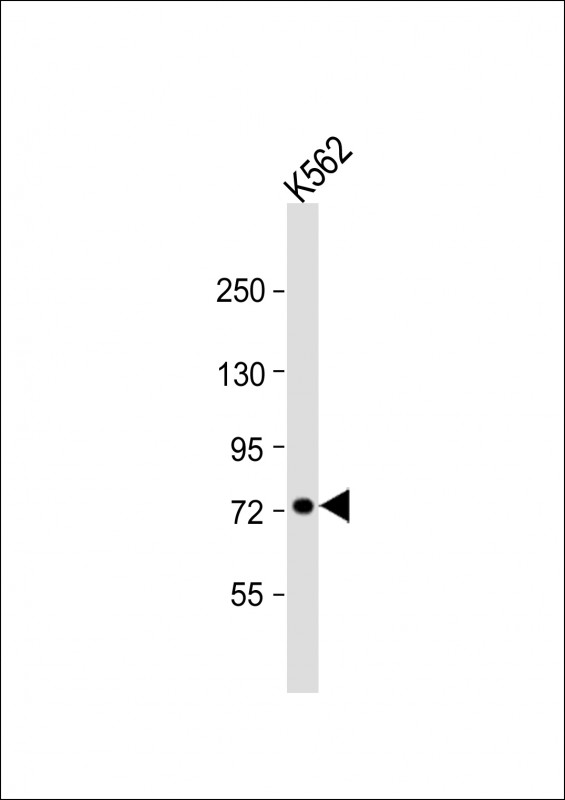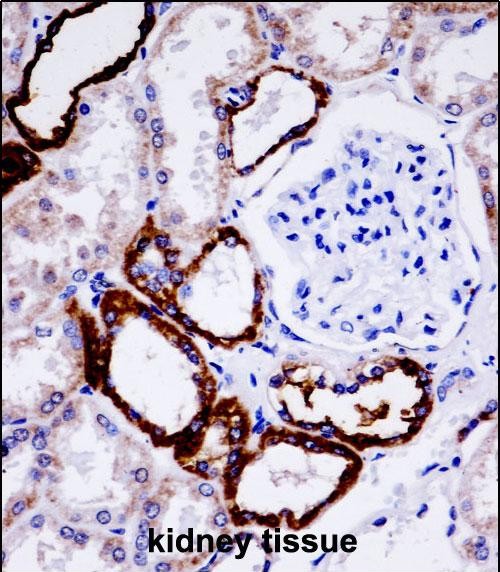UMOD Antibody (Center)
Affinity Purified Rabbit Polyclonal Antibody (Pab)
- 产品详情
- 实验流程
- 背景知识
Application
| IHC-P, WB, E |
|---|---|
| Primary Accession | P07911 |
| Other Accession | NP_003352.2, NP_001008390.1 |
| Reactivity | Human |
| Host | Rabbit |
| Clonality | Polyclonal |
| Isotype | Rabbit IgG |
| Calculated MW | 69761 Da |
| Antigen Region | 352-380 aa |
| Gene ID | 7369 |
|---|---|
| Other Names | Uromodulin, Tamm-Horsfall urinary glycoprotein, THP, Uromodulin, secreted form, UMOD |
| Target/Specificity | This UMOD antibody is generated from rabbits immunized with a KLH conjugated synthetic peptide between 352-380 amino acids from the Central region of human UMOD. |
| Dilution | IHC-P~~1:100~500 WB~~1:1000 E~~Use at an assay dependent concentration. |
| Format | Purified polyclonal antibody supplied in PBS with 0.09% (W/V) sodium azide. This antibody is purified through a protein A column, followed by peptide affinity purification. |
| Storage | Maintain refrigerated at 2-8°C for up to 2 weeks. For long term storage store at -20°C in small aliquots to prevent freeze-thaw cycles. |
| Precautions | UMOD Antibody (Center) is for research use only and not for use in diagnostic or therapeutic procedures. |
| Name | UMOD |
|---|---|
| Function | [Uromodulin]: Functions in biogenesis and organization of the apical membrane of epithelial cells of the thick ascending limb of Henle's loop (TALH), where it promotes formation of complex filamentous gel-like structure that may play a role in the water barrier permeability (Probable). May serve as a receptor for binding and endocytosis of cytokines (IL-1, IL-2) and TNF (PubMed:3498215). Facilitates neutrophil migration across renal epithelia (PubMed:20798515). |
| Cellular Location | Apical cell membrane; Lipid-anchor, GPI-anchor. Basolateral cell membrane; Lipid-anchor, GPI-anchor. Cell projection, cilium membrane. Note=Only a small fraction sorts to the basolateral pole of tubular epithelial cells compared to apical localization (PubMed:22776760). Secreted into urine after cleavage (PubMed:18375198, PubMed:26811476). Colocalizes with NPHP1 and KIF3A (PubMed:20172860). |
| Tissue Location | Expressed in the tubular cells of the kidney. Most abundant protein in normal urine (at protein level). Synthesized exclusively in the kidney. Expressed exclusively by epithelial cells of the thick ascending limb of Henle's loop (TALH) and of distal convoluted tubule lumen. |
For Research Use Only. Not For Use In Diagnostic Procedures.
Provided below are standard protocols that you may find useful for product applications.
BACKGROUND
This gene encodes uromodulin, the most abundant protein in normal urine. Its excretion in urine follows proteolytic cleavage of the ectodomain of its glycosyl phosphatidylinosital-anchored counterpart that is situated on the luminal cell surface of the loop of Henle. Uromodulin may act as a constitutive inhibitor of calcium crystallization in renal fluids. Excretion of uromodulin in urine may provide defense against urinary tract infections caused by uropathogenic bacteria. Defects in this gene are associated with the autosomal dominant renal disorders medullary cystic kidney disease-2 (MCKD2) and familial juvenile hyperuricemic nephropathy (FJHN). These disorders are characterized by juvenile onset of hyperuricemia, gout, and progressive renal failure. While several transcript variants may exist for this gene, the full-length natures of only two have been described to date. These two represent the major variants of this gene and encode the same isoform.
REFERENCES
Mollsten, A., et al. Scand. J. Urol. Nephrol. 44(6):438-444(2010)
Kottgen, A., et al. Nat. Genet. 42(5):376-384(2010)
Davila, S., et al. Genes Immun. 11(3):232-238(2010)
Gudbjartsson, D.F., et al. PLoS Genet. 6 (7), E1001039 (2010) :
Pattaro, C., et al. BMC Med. Genet. 11, 41 (2010) :
终于等到您。ABCEPTA(百远生物)抗体产品。
点击下方“我要评价 ”按钮提交您的反馈信息,您的反馈和评价是我们最宝贵的财富之一,
我们将在1-3个工作日内处理您的反馈信息。
如有疑问,联系:0512-88856768 tech-china@abcepta.com.























 癌症的基本特征包括细胞增殖、血管生成、迁移、凋亡逃避机制和细胞永生等。找到癌症发生过程中这些通路的关键标记物和对应的抗体用于检测至关重要。
癌症的基本特征包括细胞增殖、血管生成、迁移、凋亡逃避机制和细胞永生等。找到癌症发生过程中这些通路的关键标记物和对应的抗体用于检测至关重要。 为您推荐一个泛素化位点预测神器——泛素化分析工具,可以为您的蛋白的泛素化位点作出预测和评分。
为您推荐一个泛素化位点预测神器——泛素化分析工具,可以为您的蛋白的泛素化位点作出预测和评分。 细胞自噬受体图形绘图工具为你的蛋白的细胞受体结合位点作出预测和评分,识别结合到自噬通路中的蛋白是非常重要的,便于让我们理解自噬在正常生理、病理过程中的作用,如发育、细胞分化、神经退化性疾病、压力条件下、感染和癌症。
细胞自噬受体图形绘图工具为你的蛋白的细胞受体结合位点作出预测和评分,识别结合到自噬通路中的蛋白是非常重要的,便于让我们理解自噬在正常生理、病理过程中的作用,如发育、细胞分化、神经退化性疾病、压力条件下、感染和癌症。







